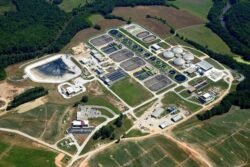
Aeration Tank Wastewater Treatment: Optimizing Oxygen Delivery for Efficient Pollutant Removal
Aeration tanks play a crucial role in modern wastewater treatment. These large tanks use air to promote the growth of helpful microbes that break down organic waste in water. Aeration tanks are the heart of the activated sludge process, which is a common and effective method for cleaning wastewater.
The process starts when wastewater enters the aeration tank. Air is then pumped into the water through diffusers at the bottom of the tank. This added oxygen helps bacteria and other microorganisms thrive. These tiny helpers eat the organic matter in the water, cleaning it in the process.
Aeration tanks come in different shapes and sizes. Some use blowers to add air, while others use mixers. The choice depends on the specific needs of the treatment plant. No matter the type, aeration tanks are key to turning dirty water into clean water that can be safely released back into the environment.
Key Takeaways
- Aeration tanks use air to help microbes clean wastewater
- The activated sludge process is a main method for water treatment
- Proper aeration is vital for effective wastewater cleaning
Fundamentals of Wastewater Treatment
Wastewater treatment is vital for protecting public health and the environment. It involves complex processes to remove contaminants and restore water quality before release.
Wastewater Management and Treatment Plant Basics
Wastewater treatment plants use physical, chemical, and biological processes to clean water. The first step is screening to remove large debris. Next, primary treatment allows solids to settle out.
Secondary treatment often uses activated sludge, where microbes break down organic matter. Aeration tanks supply oxygen to the microbes. This process removes up to 90% of contaminants.
Tertiary treatment provides additional purification through filtration or disinfection. Treated water then meets quality standards for release into waterways.
Modern plants use sensors and automation to monitor water quality. This ensures consistent treatment and regulatory compliance.
Sustainable Wastewater Solutions
Many treatment plants now focus on sustainability. Energy efficiency is a key goal, as aeration can use 50-90% of a plant’s energy. Advanced diffusers and efficient blowers reduce power use.
Water reuse is growing in popularity. Treated wastewater can irrigate crops or recharge groundwater. This conserves freshwater supplies.
Some facilities recover resources from wastewater. Biogas from sludge digestion generates electricity. Nutrients like phosphorus are reclaimed for fertilizer.
Green infrastructure, such as constructed wetlands, provides natural treatment. This approach mimics nature’s water-cleaning processes.
Biological Treatment Overview
Biological treatment uses microbes to break down organic matter in wastewater. This process removes pollutants and cleans the water. Two key parts are microbial activity and the activated sludge method.
The Role of Microbial Activity
Microbes are tiny organisms that eat waste in water. They turn harmful substances into harmless ones. Different microbes do different jobs.
Some break down carbon. Others remove nitrogen or phosphorus. The right mix of microbes is important.
Oxygen helps the microbes work better. Aeration tanks add air to the water. This makes the microbes more active.
The microbes form clumps called flocs. These flocs settle out of the water. This leaves the water cleaner.
Activated Sludge Process Explained
Activated sludge is a common way to clean wastewater. It uses tanks full of microbes to treat the water.
The process has a few steps:
- Air is added to the wastewater
- Microbes grow and eat the waste
- The microbes form flocs
- The flocs settle out in a separate tank
Blowers or mixers add air to the tanks. This helps the microbes grow. The microbes eat organic matter and nutrients like nitrogen.
The clean water flows out. Some of the settled microbes are put back in the first tank. This keeps the process going.
Aeration Tank Mechanics
Aeration tanks play a crucial role in wastewater treatment. They use oxygen and microorganisms to break down pollutants. The process involves supplying oxygen and ensuring efficient aeration.
Oxygen Supply and Oxygenation
Oxygen supply is vital for aeration tanks. It supports the growth of microorganisms that break down waste. There are two main methods of oxygen supply:
- Surface aerators: These float on the water and create turbulence to mix air in.
- Diffused air systems: These use pipes at the tank bottom to release bubbles.
The choice depends on tank size and wastewater type. Surface aerators work well for smaller tanks. Diffused air systems are better for larger, deeper tanks.
Oxygenation happens when oxygen dissolves in the wastewater. The amount of dissolved oxygen is crucial. It should be 1-2 mg/L for most industrial wastewater treatment. Too little oxygen slows down treatment. Too much wastes energy.
Aeration Process and Efficiency
The aeration process mixes oxygen with wastewater. This creates ideal conditions for microorganisms. They consume organic matter and pollutants. The process has several key factors:
- Mixing intensity
- Bubble size
- Tank depth
- Wastewater composition
Proper mixing ensures even oxygen distribution. Fine bubbles provide more surface area for oxygen transfer. Deeper tanks allow more time for oxygen to dissolve.
Aeration efficiency is crucial for cost-effective treatment. It’s measured by the amount of oxygen transferred per unit of energy used. Efficient systems can transfer up to 2 kg of oxygen per kWh.
To improve efficiency:
- Use variable speed drives on blowers
- Clean diffusers regularly
- Monitor dissolved oxygen levels
- Adjust air flow based on demand
These steps can reduce energy use by 20-50% in many plants.
Related Technologies and Considerations
Aeration tank wastewater treatment is part of a broader ecosystem of water management technologies. These systems work together to clean water and protect the environment.
Advanced Effluent Treatment Techniques
Advanced effluent treatment goes beyond basic aeration. It removes more pollutants from wastewater. One method is membrane filtration. This uses thin sheets with tiny holes to catch contaminants.
UV disinfection is another key technique. It uses ultraviolet light to kill harmful microbes. This method is chemical-free and very effective.
Activated carbon filtration absorbs organic compounds and some metals. It’s great for removing odors and improving water taste.
Nutrient removal systems target excess nitrogen and phosphorus. These can cause algae blooms in waterways. Special bacteria or chemical processes remove these nutrients.
Impacts of Wastewater on Water Quality
Untreated wastewater harms water quality in many ways. It adds harmful bacteria and viruses to water bodies. This can make people sick if they swim in or drink the water.
Nutrients from wastewater feed algae growth. Too much algae uses up oxygen in the water. This hurts fish and other aquatic life.
Chemical pollutants in wastewater can be toxic to plants and animals. Some chemicals build up in the food chain over time.
Proper treatment greatly reduces these impacts. It removes most pollutants before water returns to the environment. This protects both human health and ecosystems.
Frequently Asked Questions
Aeration tanks play a crucial role in wastewater treatment. They remove contaminants and help purify water through various processes and methods.
How does an aeration tank function in wastewater treatment?
An aeration tank adds oxygen to wastewater. This promotes the growth of helpful bacteria. These bacteria break down organic matter in the water.
The tank uses blowers or mixers to introduce air. This creates an ideal environment for microorganisms to thrive and clean the water.
What role does aeration play in the activated sludge process?
Aeration is key in the activated sludge process. It supplies oxygen to microorganisms that consume organic pollutants.
This process forms flocs, or clumps of bacteria, that settle out of the water. The result is cleaner, treated water that can be further processed or released.
What are the different types of aeration methods used in water treatment plants?
Water treatment plants use several aeration methods. These include surface aerators, diffused air systems, and jet aerators.
Surface aerators splash water into the air. Diffused air systems release bubbles from the tank bottom. Jet aerators use high-pressure nozzles to mix air and water.
What contaminants are removed during the aeration stage of wastewater treatment?
Aeration helps remove various contaminants. These include organic matter, nitrogen compounds, and some chemicals.
The process also reduces biochemical oxygen demand (BOD). This improves overall water quality and prepares it for further treatment steps.
What design considerations are important for an efficient aeration tank?
Efficient aeration tank design considers several factors. These include tank size, depth, and shape.
The type of aeration equipment is also important. Engineers must consider maintenance needs and energy efficiency when designing the system.
Why is direct contact with aerated water in treatment facilities discouraged?
Direct contact with aerated wastewater is unsafe. The water contains harmful bacteria and chemicals.
Aeration creates splashing and mist. This can spread pathogens through the air. Safety measures protect workers and visitors from exposure to these hazards.
How does an aeration tank function in wastewater treatment?
An aeration tank adds oxygen to wastewater. This promotes the growth of helpful bacteria. These bacteria break down organic matter in the water.
The tank uses blowers or mixers to introduce air. This creates an ideal environment for microorganisms to thrive and clean the water.
What role does aeration play in the activated sludge process?
Aeration is key in the activated sludge process. It supplies oxygen to microorganisms that consume organic pollutants.
This process forms flocs, or clumps of bacteria, that settle out of the water. The result is cleaner, treated water that can be further processed or released.
What are the different types of aeration methods used in water treatment plants?
Water treatment plants use several aeration methods. These include surface aerators, diffused air systems, and jet aerators.
Surface aerators splash water into the air. Diffused air systems release bubbles from the tank bottom. Jet aerators use high-pressure nozzles to mix air and water.
What contaminants are removed during the aeration stage of wastewater treatment?
Aeration helps remove various contaminants. These include organic matter, nitrogen compounds, and some chemicals.
The process also reduces biochemical oxygen demand (BOD). This improves overall water quality and prepares it for further treatment steps.
What design considerations are important for an efficient aeration tank?
Efficient aeration tank design considers several factors. These include tank size, depth, and shape.
The type of aeration equipment is also important. Engineers must consider maintenance needs and energy efficiency when designing the system.
Why is direct contact with aerated water in treatment facilities discouraged?
Direct contact with aerated wastewater is unsafe. The water contains harmful bacteria and chemicals.
Aeration creates splashing and mist. This can spread pathogens through the air. Safety measures protect workers and visitors from exposure to these hazards.

